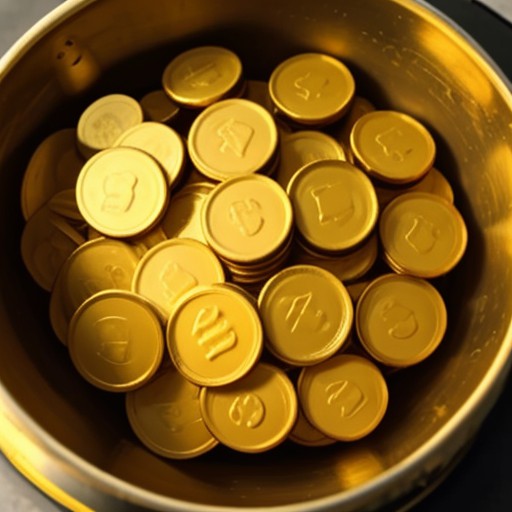FAQs
1. Gold Bullion:
Our gold bullion is gold of about 99.7% purity and is often traded in the form of bars or ingots. It is valued primarily for its metal content rather than any artistic or historical significance.
Usage: Bullion is a common investment vehicle for those looking to hedge against inflation or diversify their investment portfolio with a tangible asset.
2. Gold Bars:
Our gold bars, also known as ingots, are a popular form of gold bullion. They come in various sizes, ranging from small one-gram bars to large 400-ounce bars used by institutional investors.
Usage: Investors and institutions buy gold bars as a store of value. They are often preferred for large investments due to their relatively lower premiums compared to gold coins.
3. Gold Coins:
Our gold coins are minted by governments and come with a face value, although their market value is based on their gold content and rarity. Popular gold coins include the American Gold Eagle, Canadian Gold Maple Leaf, and South African Krugerrand.
Usage: Coins are popular among both investors and collectors. They offer an easy way to invest in gold, often with additional value from their design, limited mintage, and potential numismatic value.
4. Gold Jewelry:
Gold jewelry includes items such as rings, necklaces, bracelets, and earrings made from gold. The purity of gold jewelry varies, commonly ranging from 14 karats (58.5% gold) to 24 karats (99.9% gold).
Usage: Jewelry is bought for adornment, gifts, and cultural significance. While it can be a form of investment, the value of gold jewelry is often influenced by craftsmanship, design, and brand, in addition to the gold content.
We mainly offer online ordering options via our website and phone/email inquiries to place orders for those finding convenience in thag.
There is need to fill out a form for those who make orders via phone or email so as to capture your order details before sending you a quotation.
We strictly use bank payments to an account number availed when the process is in its final stages but for online orders, everything is automated and simple.
Our shipping options defer depening on the order quantity and destination which implies the costs differ for every customer.
1. Supply and Demand: Gold prices are heavily influenced by the basic economic principle of supply and demand. Limited supply and increased demand can drive prices up, while oversupply and reduced demand can lower prices.
2. Economic Stability: During times of economic uncertainty or instability, investors often flock to gold as a safe-haven asset, increasing its price. Conversely, when the economy is stable, the demand for gold might decrease, potentially lowering its price.
3. Inflation: Gold is traditionally seen as a hedge against inflation. When inflation rates rise, the value of currency declines, making gold a more attractive investment, which can increase its price.
4. Interest Rates: There is an inverse relationship between gold prices and interest rates. When interest rates are low, the opportunity cost of holding gold decreases, making it more attractive, which can lead to higher prices. When interest rates rise, investors might prefer income-generating assets over gold, causing prices to fall.
5. Currency Fluctuations: The price of gold is typically quoted in U.S. dollars. When the dollar weakens, gold becomes cheaper for investors holding other currencies, increasing demand and pushing prices up. Conversely, a stronger dollar can decrease demand and lower gold prices.
6. Geopolitical Events: Political instability, conflicts, and other geopolitical events can lead to increased demand for gold as a safe-haven asset, driving up prices. Conversely, geopolitical stability can have the opposite effect.
7. Central Bank Policies: Central banks hold large reserves of gold. Their buying and selling activities can significantly influence gold prices. For example, when central banks buy more gold, prices tend to rise, and when they sell, prices can fall.
8. Market Speculation: Investors' perceptions and market speculation can also affect gold prices. Positive news about the economy can decrease gold prices as investors move to riskier assets, while negative news can have the opposite effect.
Yes, our company provides secure storage solutions for customers who prefer to store their gold investments off-site which are professional storage facilities to give you peace of mind since we include advanced security to limit unauthorised access and insurance coverage in case of uncertainities we can't control like natural hazards.
STEP 1 - Assessing your precious item
Our team of expert appraisers will assess your precious items, taking into consideration the karat quality, weight and type (24K, 20K, 18K, 14K, or 10K). We take the time to evaluate each it for its special and unique value.
STEP 2 - Testing for purity
We know that your gold possesses a great personal value to you so with that in mind, our expert appraisers will handle it with the utmost care, performing an acid test to identify the purity of gold percentage. Whether you decide to sell your gold or not, you'll finally know its true value.
STEP 3 - Defining its weight
We understand your efforts and how the gold matters to you. For the most accurate of measurements, our expert appraisers use advanced techniques to determine the gram weight of your gold. Next, that gram weight is converted to a number that measures its weight in pure ounces.
STEP 4 - Testing the market
Your gold may be worth more now than when you got it. To determine that, we verify the current spot price of gold. If you do decide to sell it, no one will pay a higher price for your personal treasures than us.
STEP 5 - The offer
We will provide you with a qualified offer based on the real time value of your gold. At Gold Trade Africa, your offer can be paid out in cash or wire transfer.
1. Market Volatility: Like any other commodity, gold prices can be highly volatile. Prices can fluctuate significantly due to various factors, such as economic data, geopolitical events, and changes in investor sentiment. This volatility can result in substantial short-term losses.
2. No Yield or Dividends: Unlike stocks or bonds, gold does not produce any income, such as dividends or interest. The return on investment comes solely from capital appreciation, which may not always keep pace with inflation or other investment opportunities.
3. Storage and Insurance Costs: Physical gold requires secure storage and insurance, which can add to the cost of the investment. These additional expenses can eat into the overall return on investment.
4. Liquidity Risks: While gold is generally considered a liquid asset, there can be times when it is difficult to sell physical gold quickly without incurring significant price discounts, especially during periods of low demand or market disruptions.
5. Market Manipulation: The gold market can be susceptible to manipulation by large entities, such as central banks or major financial institutions, which can impact prices in ways that are difficult for individual investors to predict or counteract.
6. Currency Risk: Since gold is typically traded in U.S. dollars, investors using other currencies are exposed to exchange rate risks. Fluctuations in currency values can affect the real return on gold investments.
7. Regulatory Risks: Changes in government policies, taxation, and regulations regarding gold ownership and trading can impact the value and liquidity of gold investments. This is especially pertinent in countries where gold ownership is heavily regulated or taxed.
8. Opportunity Cost: Investing in gold means tying up capital that could potentially be used for other investments. During periods when other asset classes, such as stocks or real estate, are performing well, holding gold could result in missed opportunities for higher returns.
9. Economic Dependence: Gold prices can be influenced by broader economic conditions. During periods of strong economic growth, gold might underperform compared to other investments, as investors prefer assets that offer higher returns.














